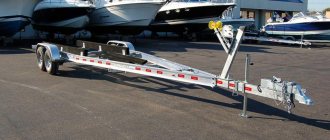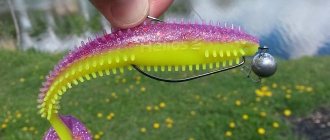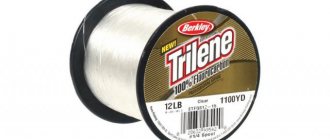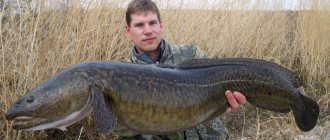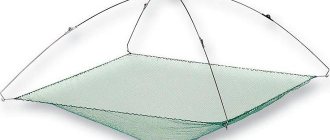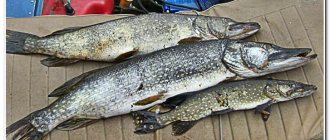Minnow fishing
very popular among fishermen.
The gudgeon is one of the few fish in fresh water whose behavior and condition can be used to judge the quality of water in a particular body of water. It thrives in clean water and completely disappears from bodies of water where the water is polluted. That is probably why this fish is a desirable catch for any fisherman. The gudgeon
is a numerous small non-commercial fish that is readily caught by amateur fishermen. The appearance of this small fish is more or less known to everyone; it is easily recognized by its large scales, cylindrical body and two small antennae that lie at the corners of its mouth. In quite rare cases, gudgeon reaches 20 cm in length and thickness of the thumb, as, for example, in the middle Volga; for the most part it is no more than 13 cm.
Content
- 1 Description and lifestyle
- 2 Habits and habitats
- 3 Features of gudgeon fishing
- 4 Methods of catching gudgeon 4.1 Catching gudgeon in a wade
- 4.2 Fishing for minnows
- 4.3 Fishing for gudgeon with a self-submersible float
- 4.4 Float rod for catching minnows
- 4.5 Fishing for gudgeon with a side nod and jig
- 4.6 Donka and half-bottom for catching gudgeon
- 5.1 Fishing for gudgeon in summer
Description and lifestyle
Gudgeon Gudgeon
is a small fish with an elongated, ridged body covered with large scales. The mouth is lower, arched, with one antennae at the corners. The lower lip is widely interrupted. The snout is long, twice the diameter of the eye. The eyes are relatively large.
The coloring is typical bottom, providing good camouflage on dark ground. The back is gray-brown, the sides are light, yellowish in large individuals. On the sides of the body there are about 10 large dark spots along the lateral line. The dorsal and caudal fins are gray-yellow, with rows of small dark spots, the remaining fins are colorless. The caudal fin is noticeably cut out.
The gudgeon reaches the age of 8-10 years, but rarely exceeds 3 years, a maximum length of 20 cm and a weight of 226 g, but the usual size is no more than 12-15 cm. Females are larger than males.
The gudgeon becomes sexually mature when it reaches a length of 8 cm. It breeds at night in spring and early summer (April-June), when the water warms up to 15°C. Spawning is portioned, on the current, in shallow places with a rocky-sandy bottom. Eggs with a diameter of 1.3-1.5 mm. stick to the ground. Fertility 1-3 thousand eggs. The eggs take about 8 days to develop. Larvae and fry eat plankton and other small invertebrates. The juveniles stay close to the shore, and as they grow, they move to deeper places.
Habits and habitats
The gudgeon is a widespread Eurasian species with a fragmented range. It is found from Portugal to the Amur basin and the rivers of the northwestern coast of the Sea of Japan. In Russia, it is common in reservoirs of both the European (with the exception of the Kola Peninsula and North Karelia) and Asian parts. Not recorded east of the Yenisei, its range is interrupted here. The gudgeon reappears in the Amur basin and in the Tugur, Uda, Suifun and Tumannaya rivers; it is absent in the rivers of the Pacific slope located north of the Amur and Uda, in Kamchatka and Sakhalin. In Mongolia it is found in the Onon, Kerulen, Khalkhin-Gol rivers and in Lake Buir-Nur. Available in China (Yalu and Liaohe rivers). It is no longer available in Japan.
Minnow distribution map
The gudgeon lives in lakes, in the lower reaches of slow-flowing rivers, and in the upper reaches of fast-flowing rivers. It is found even in slightly salty waters of the Northern Baltic. Stays near the bottom. In summer it forms small accumulations in shallow water, in winter it moves to depth. It feeds on the larvae of chironomids, mayflies, caddis flies and other insects, as well as crustaceans and mollusks (peas), and in the spring it readily eats the eggs of other fish.
Does not like cold and fast-flowing water. It lives in small schools at depths of 30 to 150 cm, and only gathers in schools during spawning.
The gudgeon's favorite places are small holes behind the rifts if the current is strong, and on the rift if it is weak. In early spring, when the water on the river is still cloudy, the gudgeon rises into rivulets and even streams - they brighten earlier. In the fall, as the water gets colder, it goes to deeper places, and in October - November (depending on the weather) it hides in deep holes and pools for the winter. You can hardly find him among the grass, and if he wanders there, it is only at night, when he comes here to hide from enemies. In general, this is a purely daytime fish.
Peculiarities of gudgeon fishing
Minnow fishing
begins immediately after the opening of rivers, lakes, ponds and continues until the onset of frost. The greatest gudgeon bite is observed in early spring. According to fishermen, at this time up to 150 fish can be caught from one place.
The summer activity of the gudgeon occurs mainly in the evening and morning dawns. But at night the gudgeon does not take it, because, as already mentioned, it prefers to lie down in the lower layers. In late autumn (November), the gudgeon goes to winter and hides in thickets of aquatic plants. But, despite this, it is also possible to catch it in winter: during the cold season, gudgeons are best caught in the deepest places. The peak bite intensity occurs when the external waters become clear.
Fishing for minnows The main fishing for minnows occurs during daylight hours, since they are a daytime fish. From the morning until about lunchtime, fishing for minnows is more productive, but in the afternoon, the activity of the fish weakens significantly. The main condition when catching gudgeon is to raise the soil that has settled to the bottom, for which turbidity is artificially created. In such “no light” the gudgeon moves fearlessly and at this moment it can be caught almost with a net.
In addition to the fact that the gudgeon takes bait especially well in the morning and evening hours, it also bites well after rains, when the water in the rivers is forced to become cloudy. Its bite is very decisive, often with the sinking of the float. However, when hooking a gudgeon, you must be extremely careful and not sweeping - this will prevent the fish’s lip from being torn by the hook, and it will not slip into the water.
The choice of bait for catching minnows depends on the fishing location. On riffles, the bite is more successful if you put a piece of a red worm or a common ironworm on the hook, which is even better. In quiet and calm places, it is preferable to fish with a whole worm (in extreme cases, half).
They also use bloodworms, which they take from 2 to 3 pieces, hooking them below its head. This attachment is ideal for a float rod and when fishing closer to autumn. At the same time, fishing for medium-sized worms is effective: when catching a gudgeon at depth, a whole worm is used, while in shallow waters, half of it is used. In spring, summer and the second part of autumn, it is best to use dung worms as bait. Gudgeons do worse on plant-grain baits, just like they do on ant eggs and maggots.
The most suitable baits for catching minnows are a medium-sized worm (small), caddis fly, and bloodworm. They are good at any time of the year. In summer you can also use wheat and steamed barley. For complementary feeding and bait, bloodworms and chopped worms are optimal, and bread is extremely rare.
Lures
It is believed that the best baits for gudgeons are a piece of worm and bloodworms. You should look for worms near the sandy shore at the water's edge under the stones. Throughout the season, caddis flies of any size and color remain an excellent bait. However, it is better to select the largest caddis flies for catching roach and white-eye, and give the small ones to the gudgeon with its small mouth.
But there are exceptions. In my practice, it happened that a large gudgeon preferred to grab maggots and practically did not react to bloodworms. Perhaps this is due to the “exit” of the caddisfly.
In the natural diet of the gudgeon, in addition to larvae and worms, plant components occupy a significant place. This is what can explain the cases of good bites on pieces of bread, dough and even pearl barley. In any case, you need to choose a nozzle that matches the size of the minnow’s mouth. This fish often simply does not pay attention to large bait.
We invite you to read: Winter feeder from ice: description of gear and features of fishing in the current
Methods for catching minnows
As you know, gudgeons are caught using float and lead rods. However, the decisive factor is the bait, which allows you to achieve the greatest success. In winter, they use a float rod or jig to catch minnows.
Catching gudgeon in a wade
To attract a gudgeon to a place, you don’t need excessively strong tricks - just stir up the soil that has settled at the bottom of the reservoir. This method of catching gudgeon is called wading. It consists of the fact that the fisherman enters the water in the traditional habitat of the fish (for minnows these are areas above the riffles) and muddies the water with his feet. In the resulting “suspension,” the minnows rise upward and may even touch the fisherman’s boots.
Fishing for minnows
For this kind of gudgeon fishing, take the lightest fishing rod with a small hook and a small float. You can also fish for gudgeon using a half-bottom fishing rod. A pellet of the required mass is selected as a load. They catch with such gear in the wiring. The depth is set by eye, making sure that the bait drags straight along the bottom. Any stop of the float is responded to with a soft hook. With this method of catching gudgeon, stirring up the water with your feet or a pole is also suitable.
Catching gudgeon with a self-submersible float
A similar method of catching gudgeon is practiced in shallow water with fast currents. Since the gudgeon is predominantly a bottom-dweller, it is best to keep the bait at bottom level. Particularly active bites are observed when the bait is dragged along its surface. Often, 2 hooks are used on a fishing line: the lower one is placed 5-10 centimeters from the upper one, which is tied on a short leash.
Float rod for catching minnows
Catching a gudgeon by retrieving does not always bring success, since it is so lazy that it will not take off and pursue a quickly floating bait. Therefore, fishing with a line without touching the bottom with a sinker is practiced only in quiet areas of water, where there are a lot of gudgeon and he waits for the food to swim straight into his mouth. If a minnow notices that a tasty morsel is slipping away, it can pursue it for a short distance. When the fish is standing on a fairly fast stream, it makes sense to fish the retrieve by dragging the nozzle and sinker along the bottom. The length of the leash should not exceed 10 cm. It is better to choose a pear-shaped float with a slightly larger carrying capacity than usual, so that it does not dive when the equipment hits a pebble or sand, but continues to drag the sinker, leash and hook with a nozzle along the very bottom in the current . In this case, stopping and slightly lowering the float is a signal of a gudgeon bite.
On the shallows of lakes and ponds with little current, the length of the leash may be slightly longer, and the float will be suitable with a narrower body. Since gudgeon fishing almost always takes place in shallow water, where the fishing depth rarely exceeds 2 m, when rigging a float rod, I always use one weight element attached close to the leader, if necessary. However, when you fish with the sinker and bait dragging along the bottom, there is a risk of snagging. Then you need to use a leash made of a thinner fishing line to avoid losing the entire line. If you fish on pond shallows free of grass and snags, then you can easily do without a leash.
Catching gudgeon with a side nod and a jig
Tackle structure with a side nod and a jig This light and mobile tackle, consisting of a telescopic rod 4-5 m long, a foam reel “filly”, a long nod, a piece of fishing line with a diameter of 0.15 mm, the length of the rod and a jig, is convenient for fishing gudgeons in sections of the river with currents of different speeds.
When playing the bait “on the rise”, minnows rarely pursue it. Considering that gudgeons in fast currents like to stand behind small water obstacles, it is worth lowering the jig to the bottom behind the stones. If the fish stand behind each other in the stream, bites may follow one after another. To activate a school of minnows, it is useful to lightly stretch the jig along the ground, keeping the line taut, and then return it to its original position, that is, make the bait freeze in a lull behind some pebble. It is better to use small or very small jigs with a hook No. 16-18. The best attachment for a jig is a piece of a small worm. Small fish with a bad bite fiddle with the bait for a long time or only tug at it, so it is very important to catch the moment to hook.
Donka and half-bottom for catching gudgeon
On various types of donkeys, gudgeons are caught along the way when catching other fish. Sometimes it will grab the worm when you fish on vast sandbanks or rocky rifts. However, donka is a rough tackle for gudgeon, sometimes you don’t even see a bite. You just take out the equipment to recast, and a small fish hangs on it. You can catch a gudgeon with a half-bottom more purposefully.
The fishing line for minnow half-bottoms (taking into account the rocky bottom or other catchy places) must be set with a diameter of at least 0.14 mm; leash - 0.12 mm. The float should not be too heavy, but such that under its weight, taking into account the strength of the current, a slight sag of the fishing line is formed, which allows you to notice any, even the weakest bite. It is best to catch a gudgeon with a half-bottom when it is completely calm. If the wind is blowing and the current is uneven, a weak gudgeon bite may not be noticed at all.
Fishing on the river
The choice of gear and fishing technique depends on the fishing conditions. It should be borne in mind that the gudgeon in the vast majority of cases takes bait from the bottom. Since the sites of this fish are rarely located at a significant distance from the shore, I fish either with a pole or a light fly rod.
Wiring to hold the bait at the fishing point on the bottom, both in uneven currents and in still water, involves the use of the simplest equipment.
During the current, the sinker with a hook can be replaced with a jig with a small hook that has a long shank, since this fish has a small mouth. This type of rig is good in shallow water with current. At a depth of more than 1 m, I always use a rig with a hook. It is very important that the equipment is located above the fishing point, and it is necessary to prevent the float, and therefore the bait, from moving from side to side.
We suggest you read: Catching chub in winter - read on Catcher.fish

To do this, I select a stable float. Most often I choose a long float with an extended upper body. If I fish with a piece of worm or in a strong current, I choose a float with a thick antenna. In the event that the depth is large and the fish stands in the deepest place, as a large gudgeon likes to do, I use a plug with a Shark Cralusso float.
It is very interesting to catch minnows without bait in small places, visually looking for large specimens. In shallow water near the shore, near vegetation, from a school of three dozen fish you can almost always select two or three specimens of decent size.
Seasonal features of gudgeon fishing
Fishing for gudgeon in summer
Fishing for gudgeon with summer fishing rods begins in April and usually ends in October. In summer it bites throughout the day, better in the morning and evening dawns. The equipment is the lightest. For small rivers this is usually a pioneer fishing rod. In any case, with a fishing rod longer than 4 m, it can be difficult to turn around in coastal vegetation.
On larger rivers, as well as on lakes and reservoirs, they fish with light carbon-fiber rods 4–6 m long. The fishing method is reeling or half-bottom, from the shore or wading. The main line is 0.1–0.12 mm. Leash 0.08–0.1 mm. A float with a carrying capacity of 1–2 g, can be feather or foam. Hook No. 13–18 with a long shank. It is better to equip the half-bottom with two hooks. Bait - bloodworms (three or four larvae per hook), caddisfly, maggots, underleaf worms, earthworms (usually only part of the worm is baited). When fishing with pellets of bread or dough, you need to take a hook with a short shank and hide it completely in the bait.
If you want to catch a sufficient amount of gudgeon, then you need to use bait. I usually use steamed millet, to which I add ground oats, so that the balls of bait are slightly washed away by the current. It’s good to add ground seeds and a little bloodworm there. As bait, you can use clay balls with pieces of worms rolled into them. The gudgeon is also suitable for ordinary streams of turbidity. For this purpose, you need to periodically pick the bottom at the fishing spot with a stick.
On forest rivers, where thickets of coastal bushes and trees interfere with fishing with a fly rod, gudgeons are caught with a summer fishing rod with a side nod and a jig. For fishing in the wilds of the forest, a fishing rod with a nod should be designed as simply as possible. To store a supply of fishing line, a small reel is used, which is mounted on the knee next to the whip. When moving along the shore, the rods are folded to the length of the line (1–1.5 m), the line itself is pressed against the rod so that it does not cling to the branches, the jig is held in the same hand as the rod. When a suitable fishing spot is found, the assembled fishing rod is pulled out over the water, the jig with bait is released and then the legs are pulled out one after the other.
The gudgeon also takes on bottom gear installed near fast jets. The design of the donkey can be of any type. Often minnows are caught when fishing with bottom rods for other fast-water fish that love rocky sandy bottoms, such as whiteeyes.
On medium and large rivers, gudgeons sometimes sit on a hook when fishing with side rods. Of course, bait, scattered with balls of mixture or lowered to the bottom in a net, plays a big role here. Any peaceful fish, including gudgeon, is suitable for bait. It is advisable to have leashes equipped with snap hooks on the side fishing rods; then, if necessary, you can change leashes with large hooks to smaller ones, minnow hooks. On some rivers in the fall, gudgeons gather in huge schools, sliding into not too deep holes in the riffles. Here he continues to feed, and if you get to such a place, you can become the owner of an excellent catch (considering that the fried gudgeon has an excellent taste and its bones are soft).
Fishing for gudgeon in winter
Fishing for gudgeon in winter Most often, gudgeon is caught in the summer, but by the way, you can successfully catch it in winter.
In addition, gudgeon is an excellent live bait for catching many predatory fish. Catching large minnows is also very interesting, which is far from uncommon in our reservoirs. Therefore, we will talk in more detail about winter fishing. Of course, she does not need any special preparation, but, nevertheless, there are some nuances. The principle of fishing is as follows: the angler makes a hole, which will be the main one, and several more are made around it, so that the main hole is in the center. We lower a light feeder with bait into this central hole, and throw ordinary winter fishing rods into the rest. The fishing rod should be equipped with the thinnest possible equipment - a fishing line with a diameter of no more than 0.12 mm, a light float or a sensitive nod and a small hook with an elongated fore-end. We use small bloodworms as bait, and catch them with larger ones.
In winter, gudgeon can also be caught with jig tackle. For this purpose, the lightest jigs are used, such as a pellet, a nymph or an ant. As noted, the best results are shown by gray and black jigs.
The game is usually played in slow motion, near the bottom. For example, these can be careful movements, with long pauses, as well as smooth oscillations at the moment when the jig comes off the bottom and rises 10-15 cm. Also, instead of a jig, you can use a hook with a pellet sinker, or a worm or bloodworm as an attachment . They fish with this kind of gear without playing, simply by placing the fishing rod on the ice. However, if there are no bites for a long time, then you can play along a little.
If during fishing the bite begins to weaken, then it is recommended to throw a little food bloodworm into the hole; if fishing is in a weak current, then a feeder is not necessary here, you can simply sprinkle bloodworms into the hole.
In general, it is best to catch gudgeon in winter in places where there is at least some movement of water. In this case, the bait will move at least somehow, which will naturally attract the attention of the fish.
In bodies of water with medium or fast currents, the gudgeon often stays near various water obstacles. In this case, the bait sinks to the bottom behind the obstacle and if there is a gudgeon there, then the bites will follow one after another. And in order to collect a school of minnows, you can lightly drag the bait along the bottom and then return it to its original position.
Adviсe
If after several good bites there is silence, then it is better to change the place. Fishing for gudgeon has its own tricks, one of them is to have several places on hand, located not far from each other. It doesn’t bite on one, the minnow has stopped or started taking small ones, it’s better to change the place of fishing. Fishing for gudgeon is a good time spent in nature and a wonderful relaxation for the soul.
I advise you to read: Catching rotan, tricks
Share with your friends!

